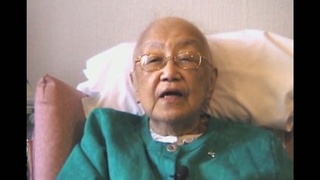Interviews
Conditions aboard U.S. transport ship while being deported from Peru
Once we got on the ship, the women and children were put in a small cabin up on deck and the men were put down below. And like older kids, like myself, we were put down below, too, with the men. And we were only allowed to go on deck twice a day for ten minutes; and during that time the women and children had to stay inside the cabin. And it took us twenty-one days to go from Callao through the Panama Canal to New Orleans. And so during that time we never got to see the family, the rest of the family.
Oh, it was terrible because it was so crowded. There were, there were bunks that you can fold, metal bunks with canvas, and you can fold 'em. And so, so during the day you can fold those bunks and then you have a little room but during the night when you bring the, those bunks down you can barely walk through it. Once we got to New Orleans, the women and children were let off the ship first and they were marching to a warehouse like. And they were, they were told to strip and stand in line naked. And then they were sprayed with insecticide, some kind of insecticide and then they would shower and they were put on the train. And then the men went through the same process. And that's the first time we saw the rest of the family together.
Date: October 26, 2003
Location: Washington, US
Interviewer: Alice Ito
Contributed by: Denshō: The Japanese American Legacy Project.





